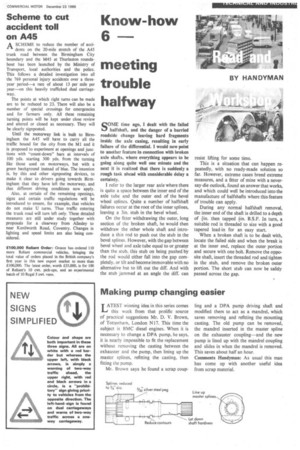Know-how 6 meeting trouble halfway
Page 25

If you've noticed an error in this article please click here to report it so we can fix it.
COME time ago, I dealt with the failed 167 halfshaft, and the danger of a hurried roadside change leaving hard fragments inside the axle casing, resulting in early failure of the differential. I would now point to another feature in connection with broken axle shafts, where everything appears to be going along quite well one minute and the next it is realized that there is suddenly a rough task ahead with considerable delay a certainty.
I refer to the larger rear axle where there is quite a space between the inner end of the axle tube and the outer end of the bevel wheel splines. Quite a number of halfshaft failures occur at the root of the inner splines, leaving a 3in. stub in the bevel wheel.
On the fitter withdrawing the outer, long section of the broken shaft, he would then withdraw the other whole shaft and introduce a thin rod to push out the stub in the bevel splines. However, with the gap between bevel wheel and axle tube equal to or greater than the stub, this stub on being pushed by the rod would either fall into the gap completely, or tilt and become immovable with no alternative but to lift out the diff. And with the stub jammed at an angle the diff. can
resist lifting for some time.
This is a situation that can happen repeatedly, with no ready-made solution so far. However, extreme cases breed extreme measures, and a fitter of mine with a neversay-die outlook, found an answer that works, and which could well he introduced into the manufacture of halfshafts where this feature of trouble can apply.
During any normal halfshaft removal, the inner end of the shaft is drilled to a depth of fin. then tapped fin. B.S.F. In turn, a suitable rod is threaded to size with a good tapered lead-in for an easy start.
When a broken shaft is to be dealt with, locate the failed side and when the break is at the inner end, replace the outer portion and secure with one bolt. Remove the opposite shaft, insert the threaded rod and tighten in the stub, and remove the broken outer portion. The short stub can now be safely passed across the gap.












































































